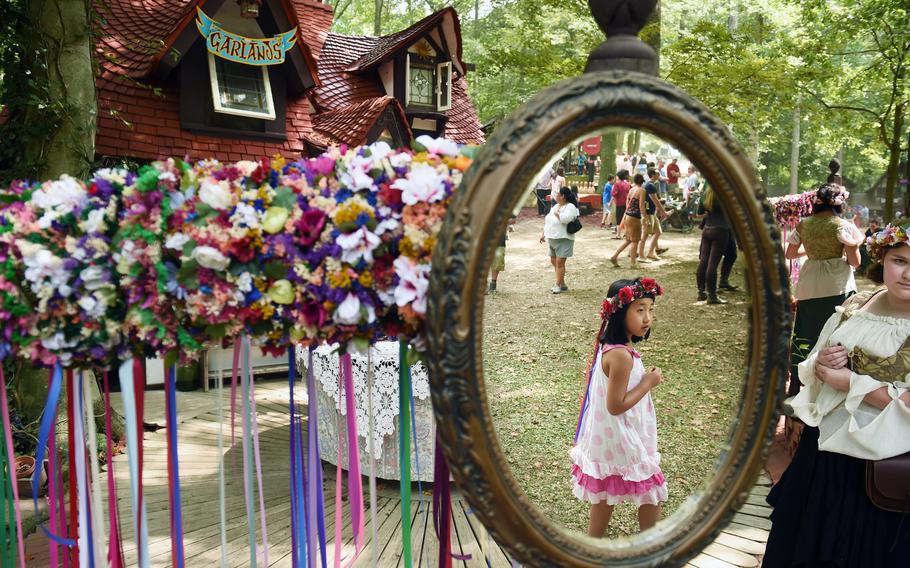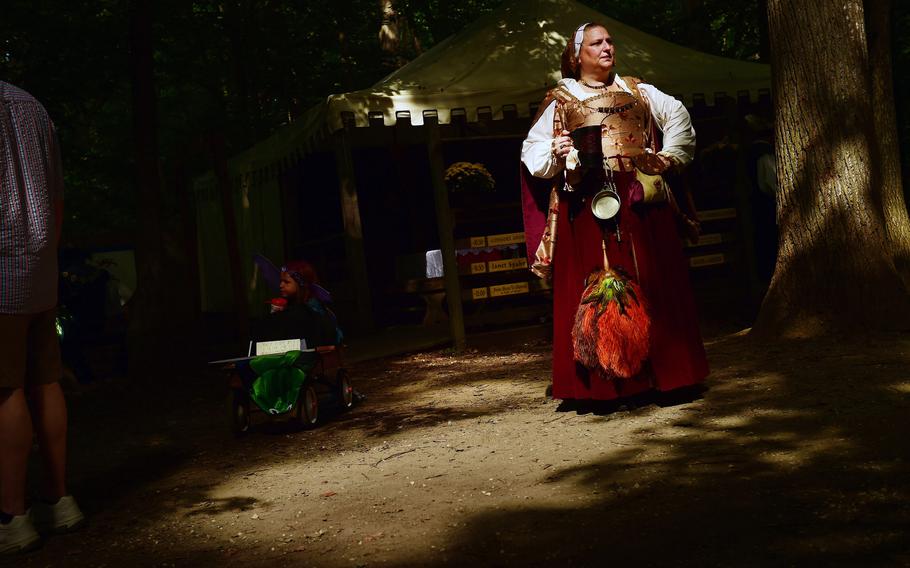
Xinyi Xie is reflected in a mirror as she walks by a booth selling garlands at the Maryland Renaissance Festival in 2015. (Matt McClain/The Washington Post)
After the pandemic, signs of economic and cultural recovery began to emerge with the return of market fairs. That was roughly 670 years ago.
History seems to be repeating itself.
European fairs before and after the Black Death were once-a-year events often tied to saint days, when traveling merchants and craftsmen set up tents on village greens to sell goods to locals also lured by food and entertainment.
Fast-forward to recent times, when folklore and fantasy stoked a nationwide boom in elaborate seasonal Renaissance festivals. At these multi-weekend events, artisans sold jewelry, candles and clothing; musicians played lutes and flutes; and fire-eaters, jugglers, acrobats and jousters performed feats of medieval derring-do. Video-jaded kids clamored for wooden shields, swords and magic wands that could last a summer of backyard play. Many fairgoers attended in costume; people-watching alone can be worth the price of admission.
In pre-COVID 2019, more than 1 million people attended more than 200 such festivals from Florida to Alberta. (For attendance and size, the Godzilla is the Texas Renaissance Festival, on 70 acres near Houston. Record-setting attendance for the 2019 run: 467,304.) But most of the fairs were shuttered for the 2020 season.
Are they back again? Verily, according to industry insiders. Falling numbers of coronavirus infections, the easing of pandemic restrictions and the festivals' outdoor settings are prompting their return. "After not going anywhere for 16 months, people want to get out, and festivals are opening all over the place," says Greg Gilbert, creator of therenlist, an online directory of such events.
A dozen or so festivals that began in the 1970s near major markets are up and clanking. Here's what you need to know.
Check dates and health regulations. Some fairs may have later-than-usual dates because of pandemic restraints. Variance among state and local restrictions for gathering size, social distancing and masks may complicate your plans.
Southern California's Renaissance Pleasure Faire, in Irwindale — the first in the United States (1963) — canceled its 2021 season, but owner Renaissance Entertainment Productions is going ahead with its festivals in Bristol, Wis. (July 10 through Sept. 6) and Tuxedo Park, N.Y., in the southern part of the state (Aug. 21 through Oct. 3).
Other standouts: the Twin Cities (Shakopee, Minn., Aug. 21 through Oct. 3), Detroit (Aug. 21 through Oct. 3), Kansas City (Sept. 4 through Oct. 17), St. Louis (Sept. 18 through Oct. 17) and Charlotte (Oct. 2 through Nov. 21). Texas, which did hold its festival in 2020, returns Oct. 9 through Nov. 28. The Maryland Renaissance Festival, near Annapolis, will be operating Aug. 28 through Oct. 24.
Sift for your interests. These history/fantasy events are not all factually set in the European Renaissance (1300-1500). Most story lines are vague and fictitious, accommodating Robin Hood as well as pirates; some point toward the England of Henry VII or Elizabeth I (the one in St. Louis is pegged to Lyons, France, in the 16th-century reign of Francis I). Some offer Shakespearean plays.
The Maryland Renaissance Festival, owned by the Smith family, spotlights the court of Henry VIII and cycles its queens to match that monarch's six spouses. According to Jules Smith, "Anne Boleyn was here in 2019 but is not present at court this year, so he is playing the field and having a dalliance with a young lady." (Watch for Queen Jane Seymour in 2022.)
Crafts? What sells best in the Midwest isn't what necessarily works in the Southwest. Potters at Southeast fests, for example, are more likely to have "face jug" pitchers native to the area.
Spend sensibly. Many festivals make their money on run-of-season stall rentals as well as food sales, so good attendance is crucial. The price of admission is kept low. Check festival websites and online and newspaper ads for discounts. Cheaper tickets are usually available at the service counters of co-sponsoring grocery chains.
Bring cash or hit on-site ATMs. While plastic is accepted at the gate and by some vendors, dollars still prevail, especially at food booths. (Popular fare includes turkey legs and stews served in bread bowls.) You'll encounter roving and stage performers who rely on donations.
Stroll the entire "kingdom" before you make purchases. Medieval tradesmen were grouped on streets with others making/selling similar wares, but festival stages, eateries and artisans tend to be interspersed for variety.
And don't worry if you don't see precisely what you want among the crafts. Many artisans have websites — which helped keep some in business during the pandemic hiatus. Grab a business card or ask if they can custom craft what you desire and make it there — larger fairs have on-grounds kilns for vendors.
Follow the weather. These outdoor affairs go on rain or shine. Seating for stages is customarily hay bales or benches. Day-after-rain dates can mean smaller crowds. Sites tend to be flat — often hayfields the rest of the year — and care is taken to dry "village streets, "but post-rain parking can require navigating mazes of muddy tire ruts.
Relax. Don't become obsessed with the day's printed schedule, advises Renlist's Greg Gilbert: "Don't over-plan your day. Be flexible. If you see some act you like, just follow it from stage to stage, through the day."

Tony Korol-Evans portrayed Mistress Anne Fermor during the opening weekend of the Maryland Renaissance Festival in 2015. (Matt McClain/The Washington Post)
Be ready to play along. Jeff Siegel, who started the Phoenix and Charlotte fairs (and, like celeb magician Penn Jillette, is a 1974 graduate of the Ringling Bros. and Barnum & Bailey Clown College) calls Renaissance festivals "one of the last bastions for vaudeville and variety shows. It is, in some ways, a traditional circus." And audience participation is a big part of the show.
"What we do is play with the audience," says Danielle Dupont, founder of Washing Well Wenches, an all-women risque comedy revue, "get the people to again be like kids in a sandbox having fun together."
She knows whom to pick by their appearance. "When the audience is being seated before showtime we try to identify (willing) people whose eyes light up," Dupont says. "We don't want to bring anyone onstage who clearly is uncomfortable."
Roaming entertainers engage with the crowds as well. Give Shamus the Insulter some cash, and he'll eloquently whittle your self-esteem. "I insult everyone equally, and with a genuine and loving heart," says Tony Miller, who has been wandering fairs for more than a quarter-century. "If the person isn't laughing, I haven't done my job."
And, as Matt Siegel, Jeff's nephew/cohort, notes, "the yearning for public display of punishment is pretty basic." You'll find it in attractions such as Vegetable Justice, where patrons hurl squishy tomatoes at the head of a performer spewing insults through a hole in a board.
But jousts are the No. 1 attraction at Ren fests. They are staged throughout the day in permanent arenas — seating in the stands may be subject to distancing guidelines this year — and some focus on skill, others on theatrics.
Even in tourneys where knights display unadulterated mounted skills by putting lances through rings and other challenges, there's room for audience participation. During the competition, each knight's cheerleaders bait the crowd to verbally slam the other guy. "Crowds at the New York fair can really be tough," says Matthew Mansour (Sir Maxxmillian, Earl of Braden), who, with Aventail Productions, provides jousting teams at five of the biggest Ren fests.
Dress for success. Consider assembling a full guise by buying a hat one year, a cape the next, etc. A quick fix for our times are hoodies tricked out to resemble the garb of lords, ladies and heraldry-specific monarchs. In terms of more elaborate costumes, Matt Siegel of the Charlotte and Phoenix fairs says 2019 saw an uptick in apparel inspired by "Game of Thrones." Some fests featured more kids and adults togged as fairies, superheroes and in "steam punk" (dystopian Victorian "Carnival Row") garb. Also trending? Costumes that reflected cultural diversity/inclusion — patrons kitted out as Nubian kings or queens, Mongol khans or princesses.
One 2019 trend that would be inappropriate for 2021 is the macabre "plague doctor" costume: a long black gown topped by a mask that featured a long, birdlike snout and goggles. While historically valid — such outfits were invented to protect doctors during the 1619 plague in Paris — they would be in questionable taste as fairgoers gather in what we hope will soon be a post-COVID America.